British shipyard, Harland & Wolff, has been awarded a £55 million contract to regenerate a former Royal Navy mine-hunting vessel, HMS QUORN. Supporting ambitions to bolster British shipbuilding, laid out in the National Shipbuilding Strategy Refresh, the regeneration will support 100 jobs at the south-west shipyard. On behalf of the Lithuanian Government, the Defence Equipment Sales Authority (DESA) awarded the contract that will see HMS QUORN renovated and restored, bolstering NATO maritime capability in Europe. The work will see an influx of contractors for the project across the local and national supply chain, with 14 major subcontract packages in engineering, equipment and integration, along with other refurbishment services. HMS QUORN completed 27 years of Service with the Royal Navy before being sold to Lithuania in April 2020. The vessel patrolled the seas as part of the Royal Navy fleet of Hunt Class Mine Countermeasures Vessels (MCMVs) until 2017.
Cdre Richard Whalley, Head of DESA, said:” This contract award reinforces our excellent working relationship that we have with Lithuania as our NATO ally as well as UK owned Harland & Wolff. We’re really pleased to see HMS QUORN refurbished in Appledore Shipyard and look forward to continuing our work with them supporting the British supply chain.”
Minister for Defence Procurement, Jeremy Quin, said:”I’m pleased that this multi-million pound contract will see a former Royal Navy mine-hunting vessel restored and regenerated in a British shipyard, supporting UK jobs and strengthening shipbuilding in the south-west. Lithuania is a key NATO ally and Joint Expeditionary Force partner, and this mine-hunting vessel will bolster NATO maritime capability across Europe, ensuring the Alliance remains ready to respond to evolving global threats.”

The Hunt Class vessels specialise in active mine-hunting. They use high-definition sonar to scour seabeds for mines, which are then destroyed by the ship’s clearance diving teams or mine disposal system. Tailored for the Lithuanian Navy, the work includes upgrades to the ships mission and sonar systems, and an additional search and rescue capability. The contract will also add new main engines, generators and propulsion gear as well as refurbish the accommodation, hull, ancillary systems, electrical systems and painting. A key NATO ally and partner in the Joint Expeditionary Force (JEF), Lithuania will add the restored mine-hunting vessel to its existing fleet, with the addition of this capability boosting NATO capability across Europe. It is planned that the ship will be handed over to the Lithuanian Navy in 2024. HMS QUORN is the third mine-hunting vessel that DESA has sold to Lithuania, following the sale of HMS Dulverton and HMS Cottesmore in 2008.
HMS Quorn, the third ship of this name, was a Hunt-class mine countermeasures vessel of the Royal Navy. She was launched on 23 January 1988, as the last ship of her class. The Hunt class is a class of thirteen mine countermeasure vessels of the Royal Navy. Upon introduction in the early 1980s they were the largest warships ever built out of glass-reinforced plastic and were the last in operation to use the Napier Deltic diesel engine. As built, they combined the separate roles of the traditional minesweeper and that of the active minehunter in one hull, but later modifications saw the removal of mine-sweeping equipment. They have a secondary role as offshore patrol vessels. All 13 ships of this class re-used names from the World War II Hunt-class destroyer. Four of the names had also been used for World War I Hunt-class minesweepers: these were HMS Bicester, Cattistock, Cottesmore and Quorn. HMS Atherstone had been a paddlewheel minesweeper in 1916, and Brocklesby was a coaster taken up from trade in 1916.















